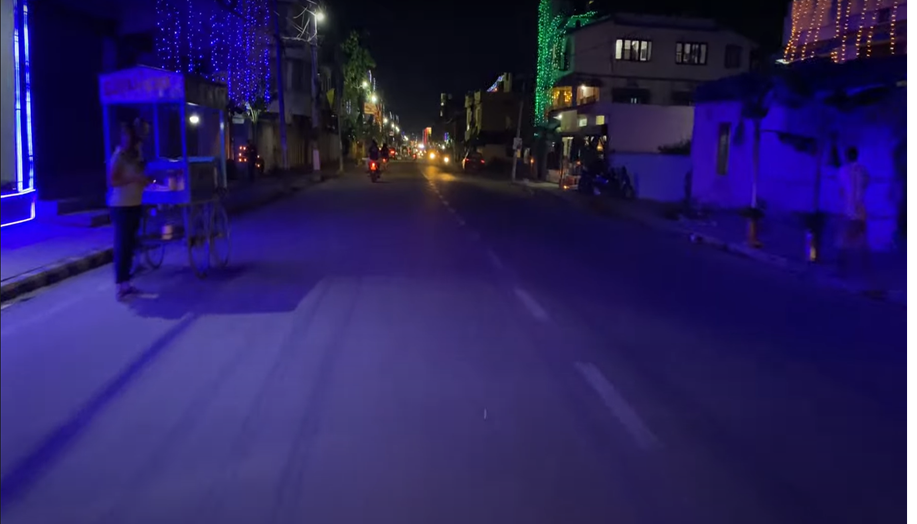Aesthetics and Lights
Everywhere, there are lights, lights, and more lights. People flock to the streets just to look at these lights, gathering like moths drawn to a flame.
Even in Biratnagar, during the months of Ashoj and Kartik, fans were rarely needed in the morning. There were times, even in the cold month of Poush, when we found ourselves needing to turn on the fans in the afternoon. I still remember the cool mornings of Kartik and the carefree joy of watching TV during school and college breaks. The sky would be clear in the mornings, birds chirping, allowing us to breathe in fresh air. Dust and smoke were rare, appearing only in areas with new road construction, and even then, mornings remained peaceful before the day’s traffic stirred.
But now, the city has changed. The roads are smoother, so there’s less dust, but what about the smoke? That has certainly increased. With the smooth roads, more bikes and cars have arrived. While the dust has slightly lessened, the air is now thick with smoke, making breathing harder than ever. We now need fans even in the early hours, and though the sky is veiled in haze, it lacks any coolness—just the heavy warmth of lingering smog. Due to which even in the mornings, it’s rare to see a clear sky. Birds have nearly disappeared and fresh air? Since winter began, that seems like a distant memory. Every day, the AQI is rising. Last winter, there was no rain, and the AQI remained three times worse than the level set by the World Health Organization throughout the season. This year, we can already assume it will be the same. It’s not just the environment here that has changed but also the beauty.
It’s not only Biratnagar; the aesthetics of all the major cities in Nepal are fading away. Perhaps I’m not the right person to talk about aesthetics. After all, I don’t know what a truly beautiful city looks like. But it doesn’t take profound knowledge of aesthetics to say that our city is not “beautiful.” That’s just common sense. We Nepalese have yet to understand that beauty is not defined merely by the sparkle of lights. In the name of beautifying the city, the spree of opening shopping malls continues. The bigger the mall, larger the crowd. Shopping malls are promoted as places to hang out. Our city streets, parks, and historical sites are falling prey to cheap commercialization, eroding their identity and cultural value.
Widening and paving streets inside residential areas to allow cars to pass has become widespread. Instead of preserving ancient craftsmanship, sculptures, and heritage, less meaningful statues are being erected. Somewhere it’s a giant tiger’s head, elsewhere a massive garlic sculpture. This is where our concept of beauty seems limited. What’s more alarming is that this trend of flaunting “beauty” is spreading nationwide. Recently, huge glass buildings have become a common sight. These buildings look identical to one another. If an entire city were constructed in this way, it would lack both beauty and history.
Similarly, lighting has become another aspect associated with beauty. The lighting is turning garish. Recently, the three major Hindu festivals came to an end. I still vividly remember how, until a few years ago, we eagerly awaited buying clay diyos for Tihar. Neighbors, especially mothers, would eagerly wait for local vendors selling clay diyos. Rooftops throughout the neighborhood would be lined with diyos drying in the sun after cleaning for tihar use. Although this tradition hasn’t vanished completely, it’s certainly fading. This year, fewer clay lamps were lit in the city. Instead, large buildings are adorned with shimmering lights. Shopping malls are brightly illuminated. Everywhere, there are lights, lights, and more lights. People flock to the streets just to look at these lights, gathering like moths drawn to a flame. We have lost our appreciation for natural beauty, covering the genuine beauty of the night with artificial adornments. Somewhere along the way, lights transitioned from a necessity to a symbol of beauty, without us even realizing it. Now, lights are only showcasing artificiality, distancing our cities from their natural surroundings.
These excessive lights are leading people into a hollow silence rather than attraction. This kind of artificial beauty contributes to a sense of detachment and increasing mental stress among people. Perhaps true beauty lies in balance, yet our cities are headed towards destroying all aspects of harmony. Our cities are showing us the real face of our imaginations, mocking our sensitivities. And sadly, we are reveling in it. Even more tragic is that we are unknowingly killing the imaginative spirit of future generations, depriving them of the beauty they deserve.









Well said. Applies to every Nepali city.